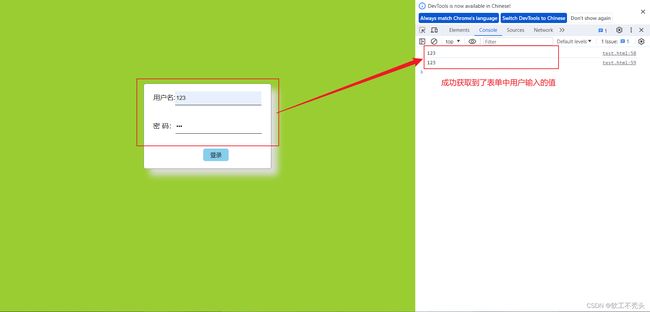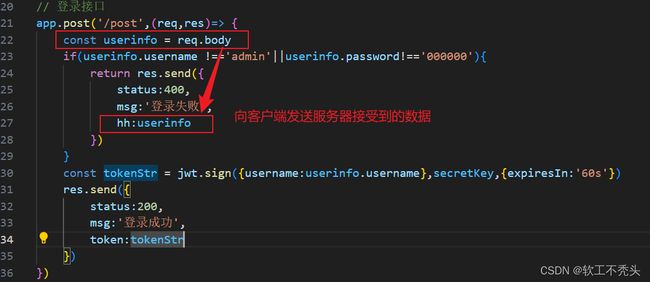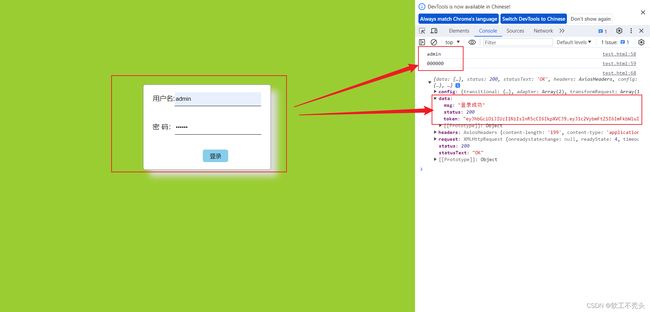在前端html页面中向服务器发送post登录请求
目录
前言
搭建服务器
搭建前端登录页面
获取表单值
使用axios发送post登录请求
前言
一般在html页面中向服务器发送post请求的模块为登录请求,本文将介绍如何向服务器发送post请求
搭建服务器
如何搭建服务器请看JWT认证这篇文章,有详细的解说。这里之所以使用JWT认证是因为在前端html页面发起post请求会有跨域问题。这里直接附上完整代码
// 导入express模块
const express = require('express')
// 创建express服务器实例
const app = express()
// 导入jwt相关的包
const jwt = require('jsonwebtoken')
const expressJWT = require('express-jwt')
// 允许资源跨域共享
const cors = require('cors')
app.use(cors())
// 解析post提交的表单数据
app.use(express.urlencoded({extended:false}))
// 定义secret密钥
const secretKey= 'notbald'
// 登录接口
app.post('/post',(req,res)=> {
const userinfo = req.body
if(userinfo.username !=='admin'||userinfo.password!=='000000'){
return res.send({
status:400,
msg:'登录失败',
hh:userinfo
})
}
const tokenStr = jwt.sign({username:userinfo.username},secretKey,{expiresIn:'60s'})
res.send({
status:200,
msg:'登录成功',
token:tokenStr
})
})
// 将JWT字符串还原为JSON对象
app.use(expressJWT.expressjwt({
secret:secretKey,
algorithms:["HS256"]
}))
// get请求
app.get('/get',(req,res)=>{
res.send({
status:200,
message:'获取用户信息成功',
data:{
username:req.auth.username
}
})
})
// 使用全局错误处理中间件,捕获解析 JWT 失败后产生的错误
app.use((err, req, res, next) => {
// 这次错误是由 token 解析失败导致的
if (err.name === 'UnauthorizedError') {
return res.send({
status: 401,
message: '无效的token',
})
}
res.send({
status: 500,
message: '未知的错误',
})
})
// 启动服务器
app.listen(3000,()=> {
console.log('server running the localhost http://127.0.0.1:3000')
})注意,这里不要使用80端口,如果使用80端口,当发起post请求时服务器引入了cors仍然会报跨域问题
搭建前端登录页面
html
css
body {
background-color: yellowgreen;
}
form {
display: flex;
flex-direction: column;
justify-content: space-around;
align-items: center;
width: 300px;
height: 200px;
border: 1px solid gray;
margin: 200px auto;
border-radius: 5px;
background-color: #fff;
box-shadow: 15px 15px 15px gainsboro;
}
input {
width: 200px;
height: 30px;
border: none;
border-bottom: 1px solid black;
}
input:focus{
outline: none;
}
button {
width: 60px;
height: 30px;
background-color: skyblue;
cursor: pointer;
border: none;
border-radius: 5px;
margin-left: 40px;
}效果图
获取表单值
首先需要先引入axios
获取表单中的值
//获取用户名的value值
const text = document.querySelector('#name').value
//获取密码框的value值
const pwd = document.querySelector('#pwd').value给登录按钮绑定点击事件,并在点击登录时打印用户输入的值
document.querySelector('#login').addEventListener('click', function(e) {
e.preventDefault()
console.log(text);
console.log(pwd);
})注意,当提交时,需要阻止默认事件发生,否则会自动刷新页面
e.preventDefault()但当我们点击登录按钮时发现,获取到的是空值
当我们在函数内定义获取到的表单中的值时,然后再打印
document.querySelector('#login').addEventListener('click', async function(e) {
e.preventDefault()
const text = document.querySelector('#name').value
const pwd = document.querySelector('#pwd').value
console.log(text);
console.log(pwd);
})成功获取到了值
原因是如果在函数外定义,那么在页面加载时会运行一次改代码,而此时的表单内是没有任何值的,所以当点击登录时获取到的是空值
使用axios发送post登录请求
打印从服务器发过来的信息
const res = await axios({
url:'http://127.0.0.1:3000/post',
method:'post',
data:({
username:text,
password:pwd
})
})
console.log(res);当我们输入正确的账号密码时发现(账号:admin 密码:000000 在服务器中写死的账号密码)
返回来的却是登录失败,所以我们查看一下后端服务器接受到的是什么数据,并向客户端发送
我们发现服务器接受到的是空值
原因是发送过去的数据格式问题,这里需要引入qs.stringfy(data),将传过去的对象格式化为字符串
直接在终端安装qs
npm install qs然后引用
const res = await axios({
url:'http://127.0.0.1:3000/post',
method:'post',
data:Qs.stringify({
username:text,
password:pwd
})
})
console.log(res);引入qs库以后,服务器可以成功获取到客户端的数据
根据服务器返回的status状态码使用window.location.href='跳转页面路径'来进行页面的跳转
if(res.data.status == 200){
alert('登录成功')
window.location.href='退出.html'
}else {
alert('登录失败')
}完整代码
document.querySelector('#login').addEventListener('click', async function(e) {
e.preventDefault()
const text = document.querySelector('#name').value
const pwd = document.querySelector('#pwd').value
const res = await axios({
url:'http://127.0.0.1:3000/post',
method:'post',
data:Qs.stringify({
username:text,
password:pwd
})
})
if(res.data.status == 200){
alert('登录成功')
window.location.href='退出.html'
}else {
alert('登录失败')
}
})这样就完成登录的post请求






